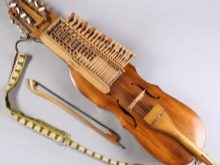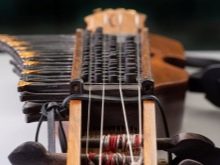All about nickelharp

Nickelharpa is a Swedish musical instrument with a history spanning about 6 centuries. During this time, of course, it underwent significant changes, but the musical possibilities expanded so much that its sound became comparable to the playing of a small string orchestra.
The appearance of the instrument is striking in its complexity - playing and resonating strings, keys in several rows, as well as the bow required when playing it. Find out more about this tool that came to us from the Middle Ages from our article.



What it is?
Nickelharpa is considered a Swedish folk musical instrument. Locals played it in medieval times. There are other variants of its name, which appeared due to different interpretations of the transcription of the Swedish nyckelharpa. The name of the instrument was formed from two words: nickel and harpa. The first in translation into Russian means "key", and the second does not have an unambiguous translation, since it implies a whole group of stringed instruments. Nickelharpa has a rather unusual appearance, which is difficult to compare with something familiar to the eye of a modern person. If this device can be compared with anything, it is only with the ancient Germanic wheeled lyre, since they have similar keyboards made of wooden keys.
In this case, the first is equipped with strings that have a different function. On the keys of Nickelharpa there are protrusions - tangents. They look like specially shaped cams perpendicular to the keyboard. By holding the key, the musician thereby presses the string with a cam-protrusion, changing its sound. The spaces between the touching points of the playing strings and the tangents create the tuning of the instrument. In some neighboring countries, the Swedish origin of this instrument is disputed.Yet most musicologists agree that its origins are originally Swedish.
Along with the clavichord, Nickelharpa is Sweden's valuable contribution to world music history.



A few historical facts about the instrument will be of interest to lovers of ancient musical instruments.
- One of the earliest mentions of Nickelharp is the image on the gate to the Shchelyung Church on the island of Gotland. It shows two musicians playing this instrument. Historians date this image to 1350.
- In the Middle Ages, nickelharpa was often depicted on churches, especially many such images can be found in the province of Uppland. It was invariably painted in the hands of angels, which speaks of a special attitude towards nickelharp, because many musical instruments were honored to be depicted only in the hands of doctors and animals. At the same time, nickelharpa was considered the tools of the poor. In novels written for the privileged nobility, she was usually associated with something primitive and ordinary.
- According to old documents, in the 18th century, references to nickelharp appeared in all parts of Sweden. She was often spoken of as an attribute of the inns of Stockholm.
- In modern history, the 1970s became an important period for this instrument. At that time, another revival of national culture began in Sweden, which prompted many musicians to take this instrument in their hands.
- The nickelharpa is immortalized on the 50 kronor note, and the tonal range of the diatonic nickelharpa is on a Swedish postage stamp.
- This instrument is also played in Finland, but there it is called avainviulu.



Views
At first, the Swedish nickelharpa had a completely different look. In particular, there were no metal resonant strings on it at all. In Sweden, as in all of Europe, they appeared after establishing trade relations with Arabs and Indians. It is metal that allows you to get a melodic and harmonious sound. As a result, Nickelharp's voice began to sound richer and more voluminous. Over the long period of its existence, other features of the instrument have also changed. Side cutouts appeared on the case, like those of violins.
Earlier models of the instrument had only one row of keys. Today they can be arranged in several rows - up to four. If earlier the range of nickelharpa made it possible to extract up to 12 sounds, now it is from 30 to 40. In the modern variation of the instrument there are 37 wooden keys equipped with a slide, along which they can easily rise to the string and clamp it.
And also the musician uses a bow - it is in the right hand. The left hand is operated with the keys during the game.



How does it sound?
Nickelharpa's range is three octaves. The lowest sound is a small octave G (like the 4th string of a violin). The sound of the instrument is somewhat reminiscent of a violin, but it has a much greater resonance. The tangent key structure helps to achieve precise tuning of all tones. The position of the working parts of the tangents can be modified by tuning one or another string. Usually in modern models of the instrument there are three rows of tangents and three playing strings A1, C1, G. A monotone (bourdon) string sounds like C.
Twelve resonant strings are tuned to the following sounds: F, A #, E, F #, C, G, D, A, D #, B, C #, G #. They are stretched lower than the playing ones, so the bows do not touch them. Three of them are located between the first and second game, three more - between the second and third, and six - between the third and monotonous. Nickelharpa is hung around the neck with a belt. But when it is placed on the chest, the resonance effects are muted. To avoid this, some musicians use a brace that slightly moves the instrument away from the chest. Due to this, it sounds freer.


Application
Nickelharpa has become one of the symbols of the national culture of Sweden, earning a place on one of the banknotes of this state. In the 90s of the last century, she entered the honorary list of musical instruments that are studied at the Faculty of Folk Music of the Royal College of Music in Stockholm. Not only admirers of the country's cultural traditions, but also modern folk groups began to play on nickelharp. Nowadays, the ancient nickelharpa has long ceased to be the property of exclusively Swedish musicians.
This instrument is played in different parts of the world. For example, in Germany and France there are contests for playing the Swedish nickelharp. They collect admirers of a rare instrument from all over the world. Admirers of nickelharpa also have their own association in America (The American Nyckelharpa Association), which, through Internet communications, has rallied fans of the instrument from different countries.



There are nickelharpists in Russia as well. You can hear how the instrument sounds by listening to the compositions of the Chorus, Gardarika groups and individual musicians who fell in love with this original instrument with a long history.
The ancient nickelharpa, known since the Middle Ages, remains a popular tool even today. The combination of keys and strings allows you to create rich sounding melodies. It gives a feeling of closeness to the origins of folk music genres. Connoisseurs of national musical instruments will undoubtedly be interested in listening to the bewitching voice of Nickelharpa, and perhaps even learning how to play it.










